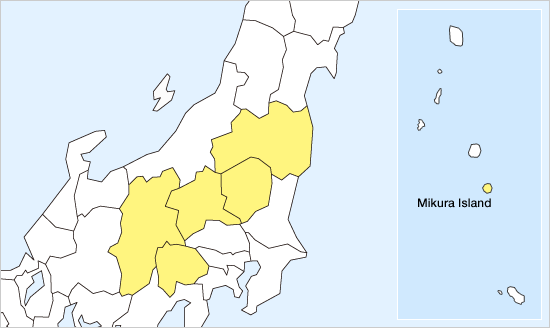Hydro power is a purely domestic energy source for resource-scarce Japan and excels in both eco-friendliness and stability.
TEPCO owns 163 hydro power stations with a total output of approximately 8,980 MW. They are located in the Tonegawa River system mainly in Gunma and Tochigi Prefectures, the Shinanogawa River system running across Nagano and Niigata Prefectures, and the Sagamigawa and Fujigawa River systems in Yamanashi Prefecture.
Hydro power generation was once the mainstream power generation system in Japan. However, as demand for electricity soared with the nation's economic development, the primary type of power generation shifted from hydro power to thermal power by 1959.
Nevertheless, because of their favorable characteristic of being easy to start and shut down, hydro power plants today play the crucial role of adjusting output during peak demand hours.
Although large-scale plants have been dominant in hydro power generation, there is a recent trend toward effectively using even unused water resources. Hydro power generation for a maximum output of up to 1,000kW is particularly called "small hydro power generation."
TEPCO operates 19 hydro power stations with a maximum output up to 1,000 kW to utilize untapped energy sources (as of May 15,2012).

| Plant name | Prefecture | Maximum Output (kW) | Number of generators |
Type | River system | River | Commence- ment of operation |
|---|---|---|---|---|---|---|---|
| Sawanagawa | Tochigi | 190 | 1 | Waterway | Nakagawa river | Sawanagawa river | 1925.10 |
| Kurokawa | Tochigi | 920 | 1 | Waterway | Nakagawa river | Kurokawa river, Yosasagawa river | 1921.7 |
| Syoubugahama | Tochigi | 450 | 1 | Waterway | Tonegawa river | Jigokugawa river | 1916.12 |
| Togawa | Tochigi | 240 | 1 | Dam | Tonegawa river | Togawa river | 2011.1 |
| Ayado | Gunma | 670 | 2 | Waterway | Tonegawa river | Tonegawa river | 1998.4 |
| Nerigawa | Gunma | 1,000 | 1 | Waterway | Tonegawa river | Nerigawa river, Akagisawagawa river | 1920.12 |
| Torao | Gunma | 270 | 1 | Waterway | Tonegawa river | Kannagawa river | 2011.11 |
| Oshino | Yamanashi | 800 | 1 | Waterway | Sagamigawa river | Sagamigawa river | 1922.8 |
| Tsuchimurogawa | Yamanashi | 350 | 1 | Dam | Sagamigawa river | Tsuchimurogawa river | 1999.12 |
| Kamanashigawa Daisan | Yamanashi | 1,000 | 1 | Waterway | Fujigawa river | Fujigawa river | 1938.2 |
| Tsugane | Yamanashi | 700 | 1 | Waterway | Fujigawa river | Daimongawa river | 1924.9 |
| Ashigawa Daisan | Yamanashi | 530 | 1 | Waterway | Fujigawa river | Ashigawa river | 1912.1 |
| Ashigawa Daini | Yamanashi | 380 | 1 | Waterway | Fujigawa river | Ashigawa river | 1906.7 |
| Ashigawa Daiichi | Yamanashi | 470 | 1 | Waterway | Fujigawa river | Ashigawa river | 1900.8 |
| Mikurajima | Tokyo | 50 | 1 | Waterway | Kawadagawa river | Kawadagawa river | 1957.9 |
| Tonokuchizeki Daini | Fukushima | 850 | 1 | Waterway | Aganogawa river | Kanayamakawa river | 1919.6 |
| Inekoki | Nagano | 510 | 1 | Dam | Shinanogawa river | Azusagawa river | 1999.4 |
| Tochigawa | Nagano | 1,000 | 1 | Waterway | Shinanogawa river | Nakatsugawa river, Tochigawa river | 2010.12 |
| Omachishinsegi | Nagano | 1,000 | 1 | Waterway | Shinanogawa river | Kagogawa river | 2012.5 |
Torao Hydro Power Station in Gunma Prefecture is a small hydroelectric power station with a maximum output of 270 kW that commenced operation on November 25, 2011.
It is TEPCO's first power station that uses a water bypass way. The plant effectively utilizes the head from the water bypass way for the Ueno Dam, which is the lower dam of our Kanagawa Pumped Storage Hydro Power Station.
To prevent river water from being stored in the reservoir more than necessary, the water bypass way is designed to bypass river water in the upstream of the reservoir and release it in the downstream of the dam. TEPCO has enabled the use of natural energy by building a small power station that takes advantage of the waterway's drop of about 101 meters.
| Place | Ueno-mura, Gunma prefecture |
|---|---|
| Maximum output | 270kW |
| Effective head | approx. 101 m |
| Maximum water use | 0.35m3/s |
| Type of facility | Waterway system |
*Please see our press release for further information.
© Tokyo Electric Power Company Holdings, Inc.